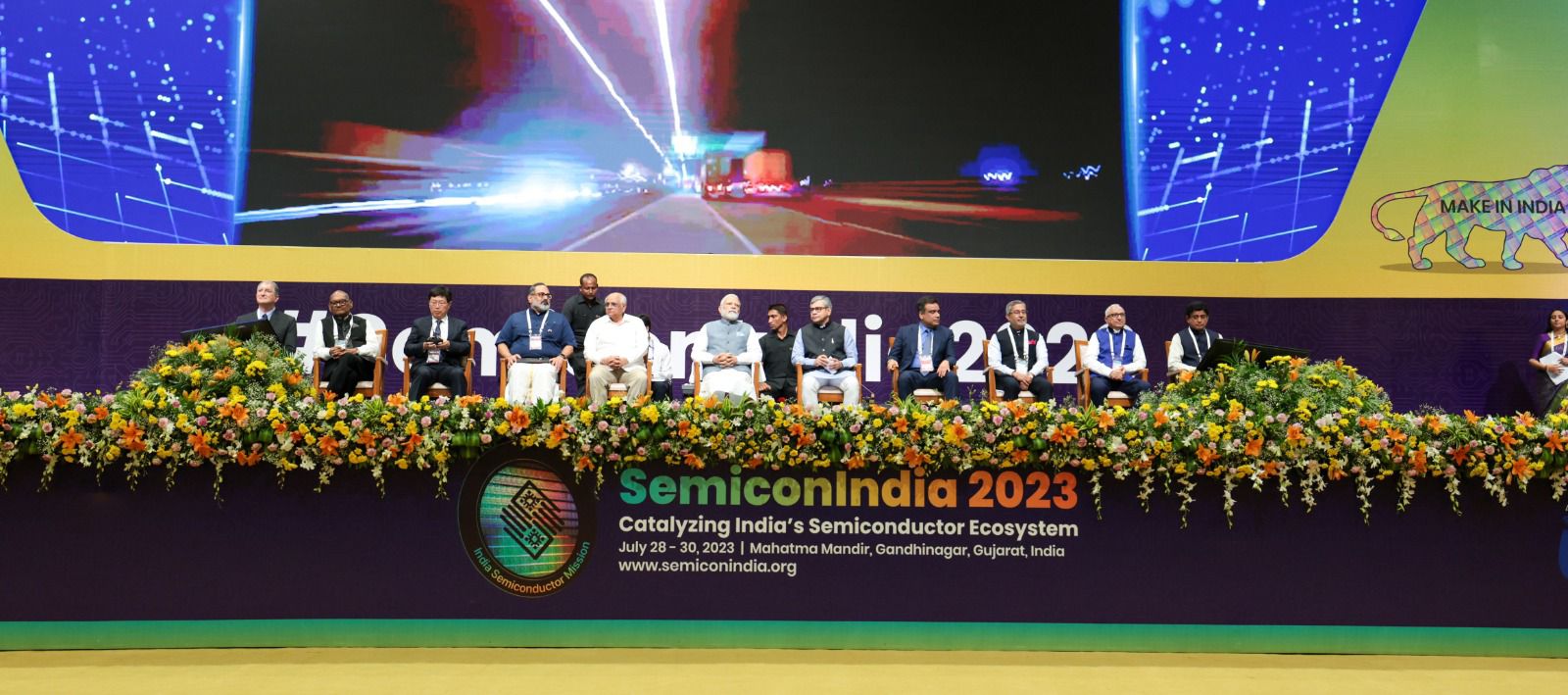


Prime Minister Narendra Modi today inaugurated SemiconIndia 2023 at Mahatma Mandir here on Friday. The theme of the conference is ‘Catalyzing India’s Semiconductor Ecosystem’. It showcases India’s semiconductor strategy and policy, which envisages making India a global centre for semiconductor design, manufacturing and technology development.
Addressing a gathering here, the PM Modi stressed that an event like Semicon is like a software update, where experts and industry leaders meet and share their expertise with each other. “This is important to harmonise our relations,” the Prime Minister said. While observing the exhibition held at the venue, he expressed his delight at the innovations and energy of the sector. He urged everyone, especially the younger generation, to visit the ongoing exhibition and understand the power of new technology.
Recalling his participation in the first edition of Semicon last year, the Prime Minister highlighted the issues raised at the time about investing in the semiconductor industry in India. He asserted that in a span of a year, the question has changed from ‘why not invest in India’ to ‘why not invest in India’. Modi said, “There has been a directional change due to the efforts of industry leaders.” He honoured him for showing faith in India. He said that industry leaders have joined India’s aspirations and capabilities with their own future and dreams. “India does not disappoint,” he said. Modi talked about the immense opportunities in 21st century India and said that the country’s democracy, population and dividends will double and triple India’s trade and commerce.
Referring to Moore’s principle, his heart grew rapidly. He said that we are seeing the same rapid growth in India’s digital and electronic manufacturing sector. He informed that India’s participation in global electronic production has increased manifold. In the year 2014, India’s electronic production was less than 30 billion dollars, which has crossed 100 billion dollars today.
Exports of electronics and mobile devices have doubled in the last 2 years. Throwing light on the development related to technology in India after 2014, the Prime Minister informed that before 2014, there were only two mobile manufacturing units in India but now, this number has crossed 200. He also informed that the number of broadband users in the country has increased from 6 crore to 80 crore, while the number of internet connections has increased from 25 crore to more than 85 crore today.
Referring to these figures, the Prime Minister stressed that this not only shows India’s progress, but is also indicative of growing trade and commerce in the country. Prime Minister Modi highlighted the important role of India in aiming for rapid growth of the semicon industry.
Prime Minister Modi noted, “Today the world is witnessing the revolution of Industrial 4.0.” He noted that the basis of any industrial revolution in the world is the aspirations of the people of that particular sector. He said, “There was a similar relationship between the industrial revolutions of the past and the American dream.” He drew parallels between the Industry 4.0 revolution and India’s aspirations. He said that Indian aspirations are the driving force behind India’s development. He referred to a recent report which stated that poverty is declining very rapidly, leading to the emergence of a nascent middle class in the country. Noting the tech-friendly nature and the eagerness of the Indian public to adopt technology, the Prime Minister said that cheaper data rates, quality digital infrastructure and uninterrupted power supply in villages are increasing the adoption of digital products. “Be it health, agriculture or logistics, India is working towards a vision of using smart technology,” Prime Minister Modi said. He noted that there are people in India, who have not used basic home appliances, but are going to use connected smart devices. Similarly, the Prime Minister said that a certain student population may not have used bicycles earlier, but now they use smart electric bikes. “India’s growing neo-middle class has become the powerhouse of India’s aspirations,” the Prime Minister said. He emphasized that the chip-making industry is a market full of opportunities and expressed confidence that those who start early will have a first-mover advantage over others.
Referring to the side effects of the pandemic and the Russia-Ukraine war, the Prime Minister said, the world needs a reliable supply chain. “Who can be a more reliable partner than the world’s largest democracy,” he said. He expressed happiness over the growing global confidence in India. “Investors trust India because it has a stable, accountable and reform-oriented government. Industry trusts India because infrastructure is developing in every sector. Technology sector trusts India because technology is growing here. Semiconductor Industry India is trusted because we have a huge talent pool.”
“Skilled engineers and designers are our strength. Anyone who is in the world’s most vibrant and integrated market wants to be a part of, has faith in India. When we ask you to make in India, it also means let’s make for India, make for the world.”
The Prime Minister said that India understands its global responsibilities and is working on a comprehensive roadmap with friendly countries. That is why India is building a vibrant semiconductor ecosystem. Recently the National Quantum Mission was approved. Apart from this, the National Research Foundation Bill is also going to be introduced in the Parliament. The engineering curriculum is being redesigned to build the semiconductor ecosystem.